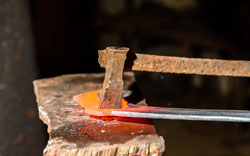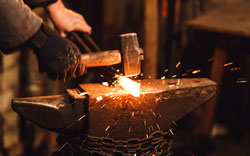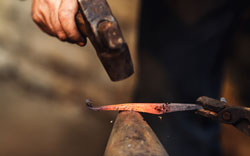 Sometimes we wonder how our readers stumble upon these pages. Sure, it’s always a good idea to research the steel that’s used to make a particular knife blade, or even the steel for swords and axes. But the 8620 steel, like so many low-carbon steel alloys, aren’t exactly used for commercial knives.
Sometimes we wonder how our readers stumble upon these pages. Sure, it’s always a good idea to research the steel that’s used to make a particular knife blade, or even the steel for swords and axes. But the 8620 steel, like so many low-carbon steel alloys, aren’t exactly used for commercial knives.
Still, if you’re intellectually curious then this guide will certainly satisfy your curiosity about 8620 steel. You’ll know about how it’s used, and whether it can be used for knives. The guide describes the notable characteristics of 8620 steel, its pros and cons, and even its chemical composition. In the end, you may even be able to use the 8620 steel to make custom knives of your own!
What is 8620 Steel?
The 8620 is a grade of steel that gives you a nice combination of wear resistance and toughness, and it’s meant mainly for industrial uses. It’s known to have good internal strength, but the strength on the outside is even greater. The 8620 steel is usually used for carburizing to develop a case-hardened part. This case-hardening process is generally responsible for its good wear resistance.
It’s regarded as a mild steel—it does have carbon, but it’s not all that much. It’s also regarded as a low alloy steel, because only a small percentage of its content is made up of alloying elements. It contains molybdenum, chromium, and nickel as well.
Some also call the 8620 steel as a case hardening steel. That is, it can easily undergo a processing method that hardens only the outer surface of the metal.
The 8620 steel is often sold in the form of round bars. But you can also get the 8620 steel in square bars, steel plates, and even in tube form.
Common Uses of 8620 steel
The 8620 steel can be a bit strong, which is why it’s often used for certain situations where the parts need to have medium-level strength. These parts include:
- Camshafts
- Fasteners
- Gears
- Chains (or chain pins)
- Arbors
- Bearings
- Bushings
- Differential pinions
- Guide pins
- King pins
- Pistons pins
- Splined shafts
- Ratchets
- sleeves
8620 steel Chemical Composition
- Carbon, 0.18% to 0.23%
- Manganese, 0.7% to 0.9%
- Nickel, 0.4% to 0.7%
- Chromium, 0.4% to 0.6
- Molybdenum, 0.15% to 0.25%
- Silicon, 0.15% to 0.35%
- Sulfur, 0.04%
- Phosphorus, 0.035%
 Carbon, 0.18% to 0.23%: This is very mild steel, and its resulting hardness doesn’t even qualify for the HRC scale. But it does offer good strength, especially when compared to non-carbon steels.
Carbon, 0.18% to 0.23%: This is very mild steel, and its resulting hardness doesn’t even qualify for the HRC scale. But it does offer good strength, especially when compared to non-carbon steels.
Manganese, 0.7% to 0.9%: Like carbon it also helps with the strength of the steel. That’s why some experts rate manganese as the most important alloying element next to carbon. The manganese here also improves the surface quality of the 8620 steel.
Nickel, 0.4% to 0.7%: The nickel also helps with corrosion resistance, but in this case it’s here to give the 8620 steel its characteristic good toughness and ductility. That means it’s not as likely to chip off, unlike harder (and more brittle) steel.
Chromium, 0.4% to 0.6: Obviously, this isn’t enough chromium to qualify the 8620 steel as stainless steel. You’d need at least 10% or even 12% chromium for that. But for 8620 steel, this amount of chromium (working with the molybdenum) helps with the hardness penetration and the wear resistance. That should help the 8620 steel last longer while bearing stress loads.
Molybdenum, 0.15% to 0.25%: The molybdenum here works with the chromium to improve hardenability and wear-resistance. It also helps with the steel’s creep strength and strength in higher temperatures.
Silicon, 0.15% to 0.35%: This is one of the main deoxidizers in steel. That means it takes out the oxygen bubbles in the molten steel that can weaken the steel as a result. It also dissolves in the iron to make it stronger. But you can’t have too much silicon, as that can reduce ductility.
Sulfur, 0.04%: You really don’t want sulfur in steel, because it reduces the impact properties of the steel. Too much of it also reduces the notched impact toughness. But in tiny amounts (like in this case), it increases the machinability of the steel.
Phosphorus, 0.035%: This is another unwanted impurity that you try to limit in any steel. Even a small bit can make a steel brittle. But in tinier amounts, it boosts the tensile strength of the steel and also improves the machinability.
8620 steel hardness
The 8620 steel isn’t really all that hard, if you’re thinking about using it for a knife. It doesn’t even have an HRC rating—the hardness level is that low. It won’t really cut worth a damn, and it surely won’t hold a sharp edge.
Still, for industrial uses (like camshafts and bushings), it offers a noticeably greater strength compared to what you can get from non -carbon steels and steels with lower carbon content.
Properties of 8620 steel
Good Toughness and Ductility
What this means is that the 8620 steel won’t just crack under the weight or load. It may bend or elongate first before it cracks, and cracking can be a greater disaster in some applications.
This is mainly due to the low carbon content. A general rule in steels is that the hardness of the steel is inversely proportional to its toughness (its propensity to crack, or the opposite of brittleness). It’s for this reason that it’s widely used in so many industrial components across a lot of industries.
Great with Case Hardening
Case hardening is a process that boosts the hardness of the metal. You end up with a rather thin layer of much harder metal on the outside. Meanwhile, the inside is still tough so the whole steel isn’t too brittle at all.
Excellent Machinability
That means it’s easier to use to make the various components you want.
Offers Good Results with Polishing Operations
The polishing can have several goals. For industrial components, it removes oxidation and helps to prevent corrosion.
Easily Available
You won’t run out of the material when you’re manufacturing high-volume products.
Very Affordable
You won’t bust your budget either when you’re using 8620 steel.
8620 Equivalent Steels or Alternative
 One way to better illustrate the properties of 8620 steel is to compare it directly with other steels that are somewhat similar. If you’re in the field of manufacturing industrial components, then these comparisons can help you decide which steel alloy is actually right for the parts you’re trying to make.
One way to better illustrate the properties of 8620 steel is to compare it directly with other steels that are somewhat similar. If you’re in the field of manufacturing industrial components, then these comparisons can help you decide which steel alloy is actually right for the parts you’re trying to make.
8620 Steel vs 9310
At first glance, it makes sense to compare these 2 steels. They’re both low alloy steels with nickel and chromium.
But the 9310 steel is much more reliably stronger, and with greater toughness as well. It offers greater tensile strength and yield strength. It’s why it’s used for components that require greater strength for safety. These include high-performance helicopter transmission gears, crucial aircraft engine gears, automotive parts, and structural parts.
But the 8620 can suffice in many other situations, and it’s much more affordable to use.
8620 Steel vs 4140
The 4140 contains significantly more carbon. It also has more chromium, though it doesn’t have nickel like the 8620 steel. The greater carbon content makes the 4140 steel stronger than the 8620, but the 8620 is more versatile.
8620 Steel vs 8630
These are almost the same steel alloy, with everything the same except that the 8630 steel has a little bit more carbon. Practically speaking, that makes the strength almost the same. But the 8620 depends more on the heat treatment to give you the strength you need.
8620 Steel vs 5120
The 5120 steel contains less carbon but more chromium. The 8620 steel is generally harder, with greater elongation at break, greater fatigue strength, greater shear strength, and greater yield strength. But the 5120 steel is more affordable, while it matches many of the other 8620 steel properties.
Is 8620 steel good for Knives?
No, it’s not. It’s true that its carbon content is enough to make it wear-resistant, when you use the steel for gears and other similar industrial components. But the carbon content is just too low to give you any worthwhile edge retention capability. It may be tough, but it just won’t cut effectively.
There may be some bladesmiths who may say that it’s good practice material to work with. But the truth is that you don’t end up with any blade that’s worth anything at all, after all your efforts. Even for blade-smithing practice, there are plenty of better steel alloys you can go with instead.
Pros & Cons of 8620 steel
- Good toughness and ductility
- Great with case hardening
- Excellent machinability
- Offers good results with polishing operations
- Easily available
- Very affordable
- Not ideal for consumer items (knives, cutlery, swords, or axes)
- Doesn’t hold an edge
- Isn’t all that corrosion-resistant
Conclusion
It’s true that for regular consumers, 8620 steel isn’t really all that important. You won’t find it in your outdoor or EDC knives, or in cutlery. You also won’t find it used for axes or even for swords.
But it is an important and widely used steel in various industries. It’s used for so many items, especially components that require a nice mix of wear-resistance and toughness. You may not realize it, but you may even find the steel used in the cars you drive or in the buildings you work in!
Frequently Asked Questions
Does 8620 steel rust?
Yes, it can. It doesn’t have enough chromium to qualify as stainless steel. But it does offer terrific corrosion resistance during the static immersion and electro-chemical tests (using 3.5% NaCl solution).
You just need to be careful when working with 8620 steel to avoid corrosion issues. During the time frame between the carburizing and the previous treatment steps, the high humidity in a workshop can lead to rust issues.
can you weld 8620 steel?
Yes, you can. It can be welded at rolled conditions, using regular welding methods like arc or gas welding. It’s best if you first preheat the 8620 steel at 400 degrees F, and then after welding you do some subsequent heating.
However, once the steel has already been case-hardened or through-hardened, then welding isn’t really a good idea anymore.
